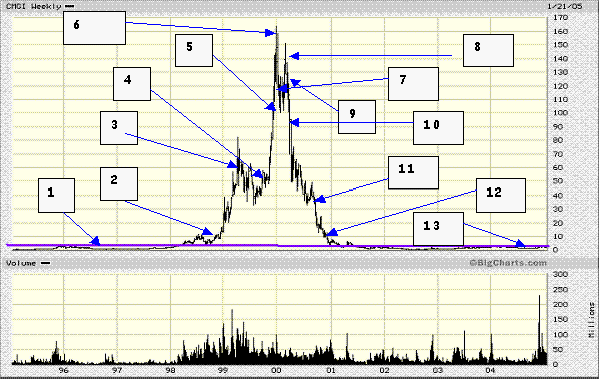It’s not the bulls and bears you need to avoid — it’s the bum steers.
~ Chuck Hillis ~

1= Stock is going no where; its pure junk, let me look at something else.
2= Lucky break, its going to definitely crash.
3= What, it’s still going up, earnings are not so good, people are definitely getting carried away, its going to pull back and crash.
4= Ahh, see I knew it was going to crash, thank God I did not buy. (Mistake the mass mindset misses the main point here. Yes, it pulled back, but look where the pullback ended–miles away from its first break out. A loser’s mind can only see the picture for what it is not by replacing it with a picture from his or her imagination. Since they live in a losing sphere they focus on the negative aspects but not on the positive aspects.
5= What happened here? This stock was supposed to crash, but how the hell did it get here? Perhaps I should have bought it; I could have made a lot of money; this looks like a sure thing. (So, only halfway through stage 5 will the mass mindset decide it’s safe to venture out. Now, this person finally musters the courage to buy.) Wow it actually went up, great, I’m making money.
6= This stock is going to go to the moon; let me tell all my friends about it; it looks like a sure thing.
7= What happened? it pulled back. Ahh, I am not going to fall for this like I fell for it last time (look at number 4). Time to buy more, buy on the dip, that’s it.
8= I knew it, its going up and I made more money, wish I had bought more. Next time I will invest more on the pull back. (Notice the loser’s mindset does not bother to take time to notice that the stock did not put in a new high. All that matters is that it went up.)
9= It’s going down again, time to really load up; I don’t want to lose this opportunity. Earnings are great so it must be a good time to buy some more.
10= First dose of bad news and the stock takes a big hit; okay, this is just temporary; it’s going to go back up. (Blind faith huge mistake, one of the main ingredients of a losing mindset). Let me buy more and average down.
11= Maybe I should sell now; things don’t look good, but you know what, let me just hold for a bit longer. Maybe things will change. Yeah, things have to change; look how fast this stock went up and it has pulled back so much. The worst is over; it has to go up.
12= This stock is dead, I have to get out; it’s not going anywhere (this is when the stocks start to bottom. The secret programmed desire to lose syndrome has completed its mission. Trader is in state of extreme distress and shell-shocked). I am never going to look at this stock again; I knew it was garbage, why did I ever buy it in the first place?
13) Slow base formations and the possible start of a new up trend, and the worst part is that this trader is out.
Conclusion
Take a close look at the above picture; the masses will react in the same way when it comes to this commodities bull market. They will dump when they should be buying and then they will try to buy when they should be selling. Nothing in this world comes easy for if it did, it was not worth it in the first place. So make sure you’re positioned well to take advantage of the coming spectacular bull market. So far we have just barely begun the first run.
This is not to be confused with the concept of buying and holding. Every now and then, it’s prudent to take some profits off the table and invest this money when there (gold, silver, oil, etc) is a pullback. However, one should always maintain a core position as long as the long-term trend is up. That’s exactly what we did; we took profits in November-December 2003 on our positions and are waiting for an opportune moment to add to them again. When we wrote an article suggesting that individuals take some profits on their gold and silver positions, we were attacked on the basis that we were trying to promote a sell off. We specifically stated that one should not sell their core positions but only take some money off the table, but everyone seemed to miss the last part of our statement. If you look closely, most of the 2004 Gold stocks did not really do anything and, in most cases, actually lost money. However, this type of behaviour is quite normal. First, you have a massive move up, then sideways to down, and then a final quick pull back to flush out all the weak hands. Now, just when everyone should be studying the charts to look for new entry points, the weak hands will start to unload their core positions, and this will indeed be a fatal mistake.
It is what we think we know already that often prevents us from learning.
~ Claude Bernard 1813-1878, French Physiologist ~
Discover Extraordinary and Informative Reads

Blackrock geopolitical risk dashboard

Harnessing the Positive Divergence Vector Field

What Is Normalcy Bias Hiding from Smart Traders?

JetBlue Carl Icahn’s High-Stakes Airline Gambit

The Greater Fool Theory Newsroom: Illuminating Financial Fallacies

Steven Fiorillo Dividend Harvesting: Revolutionizing Portfolio Growth
